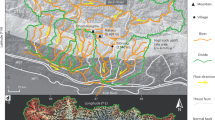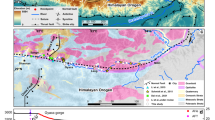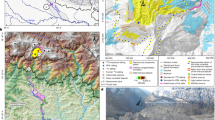Abstract
DURING the present Mount Everest Expedition, I have had the opportunity of travelling through the Central Himalaya and over part of the Tibetan plateau. The remarkable way in which certain rivers, for example, the Arun, rise in the Ladak Range about 20,000 ft. high, and then flow southwards through the considerably higher main range of the Himalaya, has been commented upon by H. H. Hayden, A. M. Heron, N. E. Odell and others; and the phenomenon has been explained either as the result of the cutting back by the rapid Himalayan torrents until they eventually captured east-to-west flowing Tibetan rivers, or as the result of the rise of the Himalaya subsequent to the establishment of the present drainage system. A method is here given which seems to make it possible to decide between these alternatives, and to distinguish two distinct phases in the formation of the Himalaya.
This is a preview of subscription content, access via your institution
Access options
Subscribe to this journal
Receive 51 print issues and online access
$199.00 per year
only $3.90 per issue
Buy this article
- Purchase on SpringerLink
- Instant access to full article PDF
Prices may be subject to local taxes which are calculated during checkout
Similar content being viewed by others
Author information
Authors and Affiliations
Rights and permissions
About this article
Cite this article
WAGER, L. The Rise of the Himalaya. Nature 132, 28 (1933). https://doi.org/10.1038/132028a0
Issue date:
DOI: https://doi.org/10.1038/132028a0
This article is cited by
-
Isostasy can't be ignored
Nature Geoscience (2012)
-
The Rise of the Himalaya
Nature (1933)



